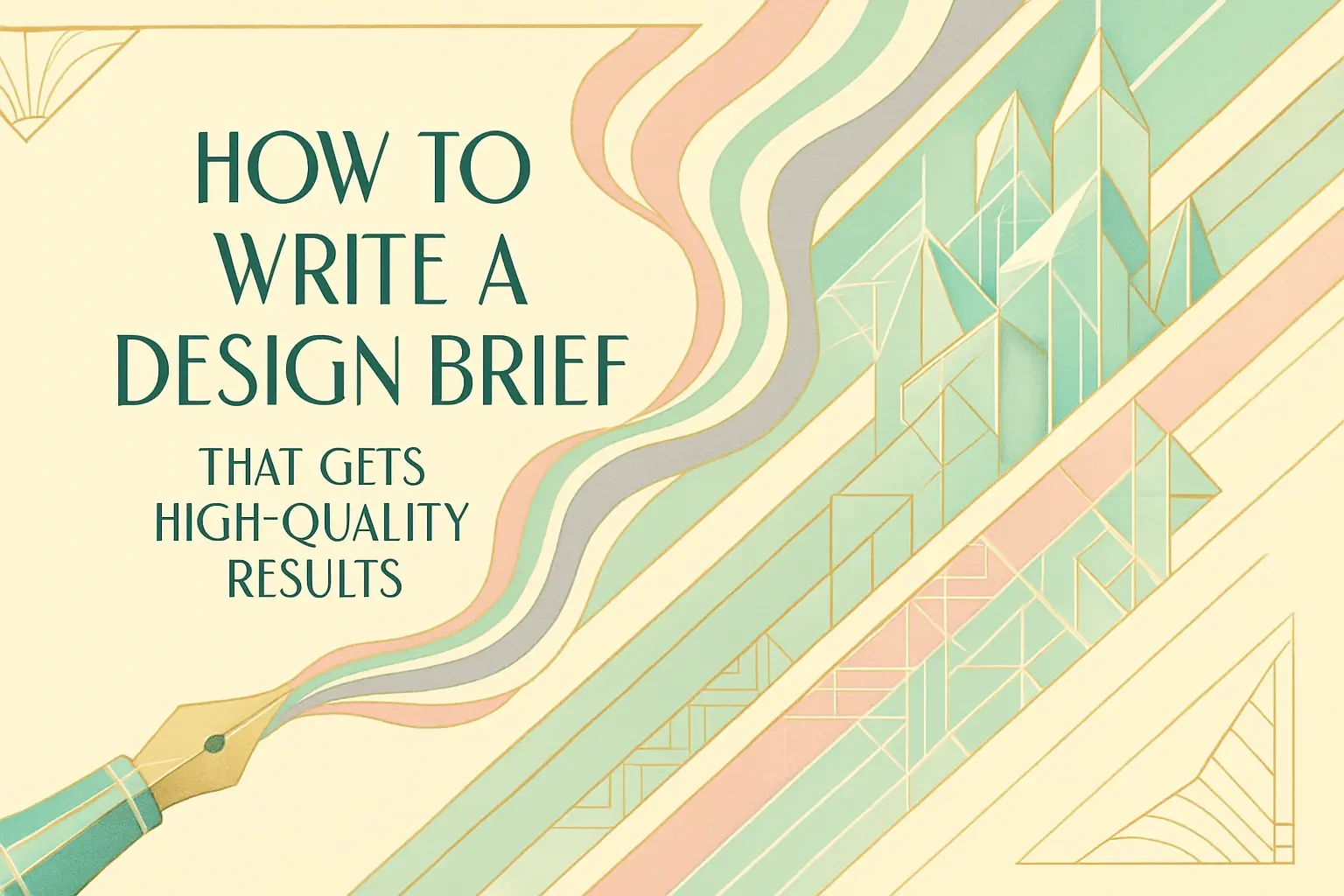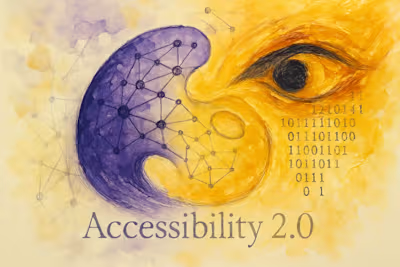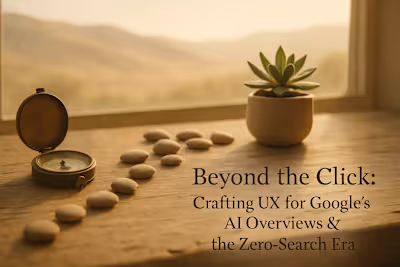How to Write a Design Brief That Gets High-Quality Results

How to Write a Design Brief That Gets High-Quality Results
Why a Great Brief is Non-Negotiable
Aligning Stakeholders and Creatives
The Foundation for Measurable Success
The Essential Elements of a High-Impact Design Brief
1. Project Overview and Company Background
2. Goals and Objectives
3. Target Audience
4. Key Message and Tone of Voice
5. Competitor Landscape
6. Scope and Deliverables
7. Timeline and Budget
8. Style, Inspiration, and Mandatories
From Brief to Brilliance: The Next Steps
References
How to Write a Design Brief That Gets High-Quality Results
Ever wondered why some design projects flow smoothly while others turn into endless revision nightmares? The secret isn't luck—it's having a killer design brief. Think of it as your project's GPS. Without one, you're basically asking your designer to read your mind, and trust me, that rarely ends well.
A solid design brief is your ticket to getting exactly what you envision, on time and on budget. Whether you're about to hire a Figma designer or you're still Choosing the Right Path for Your Project, nailing your brief is crucial. It's the difference between "perfect on the first try" and "can we just start over?" And if you want to Prep Like a Pro, mastering the art of brief writing should be at the top of your list.
Why a Great Brief is Non-Negotiable
Let's get real for a second. You wouldn't build a house without blueprints, right? Same goes for design projects. A creative brief isn't just another document to check off your list—it's the foundation that determines whether your project soars or stumbles.
Without a clear brief, you're setting yourself up for a communication disaster. Designers aren't mind readers (shocking, I know). They need concrete direction to transform your vision into reality. A well-crafted brief eliminates the guesswork and gives your creative team the roadmap they need to deliver exceptional results.
Aligning Stakeholders and Creatives
Picture this: Your marketing team wants something edgy, your CEO prefers conservative, and your designer is caught in the middle trying to please everyone. Sound familiar? This is exactly what happens without proper alignment from the start.
A comprehensive brief acts as a peace treaty between all parties involved. It captures everyone's input upfront and creates a single source of truth. When your designer has questions, they refer to the brief. When stakeholders want changes, you check them against the brief. It's like having a referee that everyone agreed to before the game started.
The magic happens when everyone reads from the same playbook. Your designer understands the business context. Stakeholders see how creative decisions support business goals. And suddenly, those painful revision cycles shrink from weeks to days. Clear communication from day one saves time, money, and sanity.
The Foundation for Measurable Success
Here's where most briefs fail—they focus on what the design should look like instead of what it should achieve. Big mistake. A powerful brief defines success in concrete, measurable terms.
Instead of saying "make it pop," try "increase newsletter sign-ups by 25%." Rather than "it needs to feel premium," specify "appeal to C-suite executives in tech companies with $10M+ revenue." See the difference? One gives your designer a target to hit. The other leaves them shooting in the dark.
When you define success metrics upfront, evaluating the final design becomes objective, not subjective. You're not debating whether blue is better than green. You're measuring whether the design achieves its intended purpose. This shift from opinion-based to goal-based evaluation transforms the entire creative process.
The Essential Elements of a High-Impact Design Brief
Now that we've covered why briefs matter, let's dive into what makes a brief truly exceptional. Think of these elements as ingredients in a recipe—skip one, and the whole dish might fall flat.
1. Project Overview and Company Background
Start with context. Your designer needs to understand who you are before they can represent you visually. This isn't about writing your company's life story. It's about providing enough background for informed creative decisions.
Include your company's mission and values. Explain what makes you different from competitors. Share your brand personality—are you the approachable expert or the cutting-edge innovator? This context helps designers make countless micro-decisions that align with your brand identity.
Don't forget to explain why this project exists. Are you launching a new product? Repositioning your brand? Solving a specific user problem? The "why" behind your project influences every design choice, from color selection to layout structure.
2. Goals and Objectives
Vague goals lead to vague results. "Improve our website" isn't a goal—it's a wish. Transform your wishes into concrete objectives that your designer can actually work toward.
Start with your primary goal. Maybe it's "increase free trial conversions by 30% within 90 days." That's specific, measurable, and time-bound. Your designer now knows that every element should guide users toward that free trial button.
Layer in secondary objectives too. Perhaps you also want to reduce support tickets by improving navigation clarity. Or maybe you need to appeal to a new market segment while keeping existing customers happy. Prioritize these objectives clearly—your designer needs to know which goals matter most when trade-offs arise.
3. Target Audience
Generic designs appeal to no one. Exceptional designs speak directly to your ideal user. But your designer can't create that connection without understanding who they're designing for.
Go beyond basic demographics. Sure, "women aged 25-40" is a start, but it barely scratches the surface. What keeps your audience up at night? What are their aspirations? How tech-savvy are they? What other brands do they love?
Paint a vivid picture of your user's day. Maybe they're busy parents checking your app during their commute. Or perhaps they're B2B buyers researching solutions during work hours. These details influence everything from font size (readability on mobile) to interaction patterns (one-handed navigation).
Include user pain points and how your product solves them. If your audience struggles with complex software, your design should emphasize simplicity. If they value efficiency, every click should count. The more your designer understands your users, the better they can serve them.
4. Key Message and Tone of Voice
Every design tells a story. What's yours? Your key message is the one thing users should remember after interacting with your design. Make it crystal clear.
Maybe your message is "Professional accounting doesn't have to be complicated." Or perhaps it's "Sustainable fashion that actually looks good." This core message should shine through every design element, from headline hierarchy to image selection.
Tone of voice brings your message to life. Are you warm and friendly like a neighborhood coffee shop? Professional and trustworthy like a law firm? Playful and bold like a startup disrupting the status quo? Your tone influences color choices, typography, imagery style, and even spacing decisions.
Provide examples of tone in action. Share copywriting samples, competitor examples you admire, or even references from other industries. The goal is helping your designer understand not just what you say, but how you say it.
5. Competitor Landscape
Your design doesn't exist in a vacuum. Understanding the competitive landscape helps your designer position you strategically in the market.
List your top 2-3 direct competitors—the companies your customers consider alongside you. Then add a couple indirect competitors who solve the same problem differently. This gives your designer crucial market context.
But here's the key: don't just list names. Analyze what works and what doesn't in their designs. Maybe Competitor A nails the premium feel but their navigation is confusing. Perhaps Competitor B has great user flow but looks dated. These insights help your designer learn from others' successes and mistakes.
Identify opportunities for differentiation. If everyone in your space uses blue and gray, maybe you own purple. If competitors feel corporate and cold, perhaps you become the warm, approachable option. Strategic differentiation starts with understanding what's already out there.
6. Scope and Deliverables
Ambiguity kills projects. Be ridiculously specific about what you need. "Design our website" could mean anything from mockups to fully coded pages. Clarity here prevents scope creep and ensures accurate pricing.
List every deliverable explicitly. Need five page designs for your website? Name them: Homepage, About, Services, Blog, Contact. Require mobile versions? Say so. Want a design system with reusable components? Include it.
Specify technical requirements too. Figma files? Exported PNGs? Interactive prototypes? Different deliverables require different effort levels. Also mention any constraints—maybe you're using a specific website builder or need to work within existing brand guidelines.
Don't forget about variations and states. A login screen needs error states. A product page might need out-of-stock versions. These details often get missed but significantly impact the project scope.
7. Timeline and Budget
Money and time—let's talk about everyone's favorite constraints. Being upfront about both saves everyone from awkward conversations later.
Break your timeline into phases with specific milestones. Initial concepts by date X. Refined designs by date Y. Final files by date Z. Include buffer time for feedback and revisions. Rushed timelines lead to rushed work, so be realistic about what quality work requires.
Budget transparency helps designers propose solutions that fit your resources. Can't afford custom illustrations? Your designer might suggest premium stock options. Limited development budget? They'll design within your platform's constraints. Constraints spark creativity when communicated clearly.
Include any hard deadlines and explain why they matter. Launching at a trade show? The designer needs to know that date is non-negotiable. Flexible on timing? Say that too—it might get you better rates or more thorough work.
8. Style, Inspiration, and Mandatories
Show, don't just tell. Visual references communicate what words often can't. But random Pinterest boards won't cut it—you need to curate thoughtfully.
Share 3-5 designs you love and explain why. "I like this website's clean navigation." "This app's color palette feels fresh but professional." "This poster's typography has the energy we want." Specific feedback helps your designer understand your taste.
Include designs you dislike too. "This feels too corporate." "These colors are too muted for our brand." "This layout feels cluttered." Knowing what to avoid is just as valuable as knowing what to pursue.
List your mandatories—the non-negotiables. Brand colors that must be used. Logos that need specific placement. Accessibility requirements. Legal disclaimers. These constraints aren't limitations; they're parameters that focus creative energy where it matters most.
From Brief to Brilliance: The Next Steps
You've crafted a comprehensive brief. Now what? The brief isn't meant to be a one-way document that you throw over the wall. It's the starting point for a collaborative conversation.
Schedule a kickoff meeting to walk through the brief together. This isn't just a formality—it's where the magic happens. Your designer will have questions. They might spot potential issues you missed. They'll suggest approaches you hadn't considered. This dialogue transforms your brief from a static document into a living project guide.
Encourage questions during this meeting. The best designers will push back on assumptions and propose alternatives. They might ask why you chose certain objectives or suggest different success metrics. This isn't resistance—it's expertise in action. Designers who care about results dig deeper to understand the real challenges.
Keep the brief accessible throughout the project. It becomes your north star when feedback starts pulling in different directions. When someone suggests a major change, check it against the brief. Does it support the stated goals? Does it speak to the target audience? The brief keeps everyone honest and focused.
Remember, a great brief doesn't guarantee great design—but it makes it much more likely. You've given your designer the tools they need to succeed. You've aligned stakeholders on clear objectives. You've defined what success looks like. Now trust the process and watch your vision come to life.
The time you invest in a thorough brief pays dividends throughout your project. Fewer revisions. Faster approvals. Better results. And most importantly, a final design that doesn't just look good—it works hard to achieve your business goals.
Ready to put your new brief-writing skills to work? Your next design project just got a whole lot smoother. Whether you're redesigning your entire brand or just need a landing page refresh, you now have the blueprint for briefing success. Time to create something amazing.
References
Like this project
Posted Jul 6, 2025
A great design brief is the foundation of a successful project. Learn the essential elements to include to ensure your Figma designer delivers exactly what you need.









